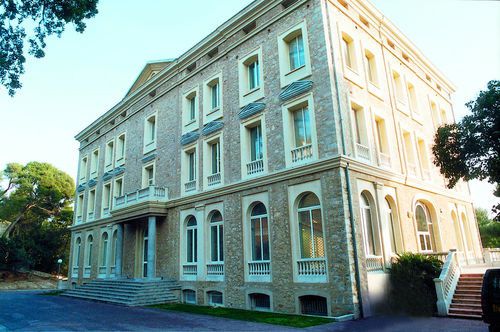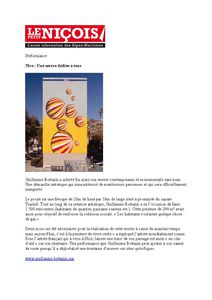Guillaume Bottazzi - 紀堯姆.波塔茲 - ギヨム・ボタジ - БОТТАЗЗИ
WELCOME TO THE POETIC WORLD OF GUILLAUME BOTTAZZI
Asia & Europe & USA & Russia
MORE THAN 100 ARTWORKS FOR PUBLIC SPACES
ordered by museums, cities, ministries, investors and collectors.

Guillaume Bottazzi - Wall painting - 20m x 10m - Nice 2011 - Copyright
Villa Tamaris Art Center (Event 10)
From 22th February to 21th March 2010

Communauté d'Agglomération Toulon Provence Méditerranée
Avenue de la Grande Maison
83500 La Seyne-sur-mer
Tél : +33 (0)4 94 06 84 00 - Fax : +33 (0)4 94 30 71 89
Paris art
La perception sensorielle est créée par une excitation ou une stimulation
qui elle-même produit une réaction.
Nous avons la faculté de voir l’objet seulement si l’information passe par le cortex.
Cela explique que notre vision n’est pas un phénomène simplement mécanique
mais qu’elle est liée à une élaboration mentale.
La perception d’une forme induit la perception d’une signification
(processus symbolique) ;
dans une image abstraite, selon les théories de la Gestalt l’ensemble de
la structure perceptive prime sur la partie.
Extrait tiré de l’ouvrage « Abrege de psychologie »,
de J. Delay et P. Pichot, 4e édition, aux éditions MASSON – Chapitre IV / La perception.
Aspects psychologiques et psychopathologiques / pages 55.
c) L’effet Tau de gelb. – Il combine les deux séries précédentes.
Lorsque trois points lumineux A, B et C, également espacés, sont présentés successivement,
l’intervalle temporel séparant A et B étant inférieur à celui qui sépare B de C,
les points A et B sont vus plus rapprochés dans l’espace que B et C.
Quelques illusions optico-géométriques. En haut à gauche, l’illusion de Müller Lyer.
Le point divise la hampe de la flèche en deux moitiés égales.
La moitié de droite paraît plus longue que celle de gauche. En haut à droite,
la ligne oblique est faite de deux segments qui sont dans le prolongement l’un de l’autre.
Le segment supérieur paraît décalé vers la droite. En bas à gauche, les bases inférieures
des trois trapèzes sont égales. En bas à droite, les six lignes sont parallèles.
Cf: schémas en bas de l'article
Les schémas ci-dessous illustrent que l’on ne voit pas les parties mais un tout,
notre vue d’ensemble crée l’illusion d’optique, nos perceptions peuvent être
faussées mais surtout notre perception réinvente le monde.
La perception n’est pas reproduction objective du monde
- Si un tableau représente une pomme (nous pouvons la définir ronde,
rouge, appréhender sa taille...), il y a un processus cognitif qui s’établit,
le sujet est identifié. La pomme renvoie à un concept de la pomme
existant chez l’observateur. Elle peut être liée à un processus affectif,
par exemple en rappelant à l’observateur un souvenir comme l’odeur
des tartes que sa grand-mère cuisinait. L’observateur est actif devant l’image.
La constance des couleurs:
Si l'on demande à un observateur de quelle couleur est le charbon en
plein soleil l'observateur la verra noire. De la même manière un tas de neige
au crépuscule apparaitra comme blanc. Mais une cellule photo électrique
montre que le charbon au soleil est plus clair que la neige au crépuscule.
Il y a une constance des couleurs dans notre cerveau et la signification
appartient à celui qui la regarde : la neige est perçue comme blanche,
invariablement.
L’image abstraite nous construit
Devant une image abstraite le processus symbolique de l’observateur
doit construire autrement l’image. En effet il ne peut dans ce cas utiliser son
expérience. L’œuvre abstraite impose un travail d’élaboration mentale, cette activité
cérébrale participe à notre développement. La lecture devient déroutante parce qu’il
n’y a pas de références, elle nous impose un travail d’élaboration en plus.
L’observateur a donc un effort à faire pour identifier l’image, la comprendre.
De plus nous voyons ce que nous avons envie ou besoin de voir.
Notre motivation détermine le champ de l’hypothèse et
donc modifie le champ de notre perception. La perception est action,
acte perceptif avec lequel nous structurons le monde. Elle est liée à l’acquis,
cela implique qu’elle évolue, il n’y a pas de caractère absolu.
cf : Les théories empiristes - Piaget/stade de l’enfant - la perception s’apprend.
Expériences Kilpatrick :
- Une chambre est tordue, les murs ne sont pas droits.
A l’intérieur un homme touche l’espace, c’est un transfert d’apprentissage,
il comprend l’espace avec ses mains et donc retrouve ses repères;
ce qui implique que la perception évolue.
- Nous mettons des lunettes inversant la gauche et la droite sur un individu.
Le cerveau réinvente alors le bon sens. La perception innée,
acquise, pulsionnelle, affective est modifiable par l’expérience.
L’art doit être porté à tous
On distingue l’acquis et l’inné dans la perception.
Une œuvre abstraite n’impose pas de sujet, elle nous délie de nos références.
Notre acquis devient déterminant, autrement dit regarder des œuvres
facilitera à créer l’élaboration mentale. D’où la nécessité de donner accès à l’art à
un large public, la présence d’œuvres participe à nos connaissances et au
développement de nos capacités. Plus on voit des œuvres d’art plus on est prêt à
les recevoir et à accepter qu'il n'y a pas une seule et unique vision du monde.
Guillaume Bottazzi
Sensory perception is created by arousal or stimulation which itself produces a reaction.
We are able to see an object only if the information passes through the cortex.
That explains why our vision is not simply a mechanical phenomenon but is also
connected to mental elaboration. The perception of a form induces the perception of
meaning (a symbolic process); according to Gestalt theory,
in an abstract image the whole perceptive system prevails over the sum of its parts.
Excerpt from the “Abrégé de psychologie” (“A compendium of psychology”),
by J. Delay and P. Pichot, 4th edition, Editions Masson – Chapter IV / La perception.
Aspects psychologiques et psychopathologiques (Perception.
Psychological and Psychopathological Aspects) / page 55 (translated here).
c) The Tau and Gelb Effect. - It combines the two preceding series.
When three equally spaced bright spots A, B and C are presented one after another and the
temporal interval between A and B is inferior to that between B and C, points A and B are
seen as closer together than B and C.
A few optical-geometrical illusions. On the upper left side, the Müller Lyer illusion.
The dot divides the arrow’s shaft into two equal halves.
The portion on the right appears longer than the portion on the left.
On the upper right side, the oblique line is comprised of two segments which are a
continuation of each other. The upper segment appears shifted to the right.
On the lower left side, the bases of the three trapeziums are equal.
On the lower right side, the six lines are parallel.

The diagrams above show that we do not see the individual parts but the whole;
our overall view creates an optical illusion, our perception may be distorted but,
above all, all our perception reinvents the world.
Perception is not an objective reproduction of the world
- If a picture represents an apple (we can define it as round, red, judge its size, etc.),
cognition begins and the subject is identified. The apple refers to a notion of
apple which exists for the observer. It can be connected to an affective process,
for example by recalling a memory such as the smell of the pies the observer’s
grandmother used to bake. The observer is active in front of the image.
The constancy of colour:
If we ask an observer what is the colour of coal in direct sunlight,
the observer will see it as black. Similarly, a pile of snow at dusk will appear white.
And yet a photoelectric cell shows that coal in sunlight is lighter than snow at dusk.
There is a constancy of colour in our brain and meaning belongs to the person
looking at it : snow is invariably perceived as white.
The abstract image constructs us
In front of an abstract image, the observer’s symbolic process must construct the
image differently. Indeed, the observer cannot rely on his or her experience in this case.
Abstract artwork commands mental effort and this cerebral activity is part of our development.
Understanding becomes disconcerting because there are no references;
it requires us to think harder.
Thus, the observer must make an effort to identify the image, to understand it.
Moreover, we see what we want to see or what we need to see.
Our motivation determines the field of hypothesis and as
such modifies the field of our perception.
Perception is action, the perceptive act with which we structure
the world. It is tied to what is acquired, which implies
that it evolves and that there is no absolute nature.
cf.: The empiricist theories – Piaget / the child’s developmental stages – perception is learned.
Kilpatrick Experiments:
- A room is crooked, the walls are not straight.
Inside, a man touches the space, a degree of transfer occurs,
he understands the space with his hands and as such finds his bearings;
this implies that perception evolves.
- We put glasses which invert left and right on an individual.
The brain then reinvents the correct direction. Innate, acquired,
compulsive and affective perception can change with experience.
Art must be brought to everyone
We can distinguish acquired from innate in perception.
Abstract artwork does not impose a subject; it frees us from our references.
What is acquired becomes a determinant; in other words,
looking at artwork will help mental elaboration. Hence the importance of
making art accessible to a large audience: the presence of artwork improves
our knowledge and the development of our capabilities. The more artwork we
see, the more we are prepared to receive it and accept that there is
no single, unique vision of the world.
Guillaume Bottazzi
Official website of Guillaume Bottazzi



